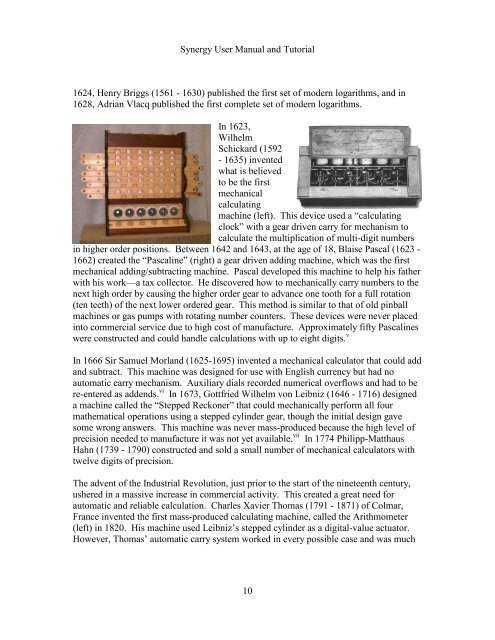Synergy User Manual and Tutorial. - THE CORE MEMORY
Synergy User Manual and Tutorial. - THE CORE MEMORY
Synergy User Manual and Tutorial. - THE CORE MEMORY
You also want an ePaper? Increase the reach of your titles
YUMPU automatically turns print PDFs into web optimized ePapers that Google loves.
<strong>Synergy</strong> <strong>User</strong> <strong>Manual</strong> <strong>and</strong> <strong>Tutorial</strong><br />
1624, Henry Briggs (1561 - 1630) published the first set of modern logarithms, <strong>and</strong> in<br />
1628, Adrian Vlacq published the first complete set of modern logarithms.<br />
In 1623,<br />
Wilhelm<br />
Schickard (1592<br />
- 1635) invented<br />
what is believed<br />
to be the first<br />
mechanical<br />
calculating<br />
machine (left). This device used a “calculating<br />
clock” with a gear driven carry for mechanism to<br />
calculate the multiplication of multi-digit numbers<br />
in higher order positions. Between 1642 <strong>and</strong> 1643, at the age of 18, Blaise Pascal (1623 -<br />
1662) created the “Pascaline” (right) a gear driven adding machine, which was the first<br />
mechanical adding/subtracting machine. Pascal developed this machine to help his father<br />
with his work—a tax collector. He discovered how to mechanically carry numbers to the<br />
next high order by causing the higher order gear to advance one tooth for a full rotation<br />
(ten teeth) of the next lower ordered gear. This method is similar to that of old pinball<br />
machines or gas pumps with rotating number counters. These devices were never placed<br />
into commercial service due to high cost of manufacture. Approximately fifty Pascalines<br />
were constructed <strong>and</strong> could h<strong>and</strong>le calculations with up to eight digits. v<br />
In 1666 Sir Samuel Morl<strong>and</strong> (1625-1695) invented a mechanical calculator that could add<br />
<strong>and</strong> subtract. This machine was designed for use with English currency but had no<br />
automatic carry mechanism. Auxiliary dials recorded numerical overflows <strong>and</strong> had to be<br />
re-entered as addends. vi In 1673, Gottfried Wilhelm von Leibniz (1646 - 1716) designed<br />
a machine called the “Stepped Reckoner” that could mechanically perform all four<br />
mathematical operations using a stepped cylinder gear, though the initial design gave<br />
some wrong answers. This machine was never mass-produced because the high level of<br />
precision needed to manufacture it was not yet available. vii In 1774 Philipp-Matthaus<br />
Hahn (1739 - 1790) constructed <strong>and</strong> sold a small number of mechanical calculators with<br />
twelve digits of precision.<br />
The advent of the Industrial Revolution, just prior to the start of the nineteenth century,<br />
ushered in a massive increase in commercial activity. This created a great need for<br />
automatic <strong>and</strong> reliable calculation. Charles Xavier Thomas (1791 - 1871) of Colmar,<br />
France invented the first mass-produced calculating machine, called the Arithmometer<br />
(left) in 1820. His machine used Leibniz’s stepped cylinder as a digital-value actuator.<br />
However, Thomas’ automatic carry system worked in every possible case <strong>and</strong> was much<br />
10

















